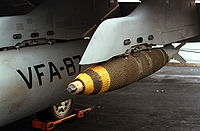
Gravity bomb
Encyclopedia

Aerial bomb
An aerial bomb is a type of explosive weapon intended to travel through the air with predictable trajectories, usually designed to be dropped from an aircraft...
that does not contain a guidance system
Guidance system
A guidance system is a device or group of devices used to navigate a ship, aircraft, missile, rocket, satellite, or other craft. Typically, this refers to a system that navigates without direct or continuous human control...
and hence, simply follows a ballistic
Ballistics
Ballistics is the science of mechanics that deals with the flight, behavior, and effects of projectiles, especially bullets, gravity bombs, rockets, or the like; the science or art of designing and accelerating projectiles so as to achieve a desired performance.A ballistic body is a body which is...
trajectory
Trajectory
A trajectory is the path that a moving object follows through space as a function of time. The object might be a projectile or a satellite, for example. It thus includes the meaning of orbit—the path of a planet, an asteroid or a comet as it travels around a central mass...
.
This described all aircraft bombs in general service until the latter half of World War II
World War II
World War II, or the Second World War , was a global conflict lasting from 1939 to 1945, involving most of the world's nations—including all of the great powers—eventually forming two opposing military alliances: the Allies and the Axis...
, and the vast majority until the late 1980s.
Then, with the dramatically increased use of precision-guided munition
Precision-guided munition
A precision-guided munition is a guided munition intended to precisely hit a specific target, and to minimize damage to things other than the target....
s, a retronym
Retronym
A retronym is a type of neologism that provides a new name for an object or concept to differentiate the original form or version of it from a more recent form or version. The original name is most often augmented with an adjective to account for later developments of the object or concept itself...
was needed to separate 'smart bombs' from free-fall bombs. 'Dumb bomb' was used for a time, but many military circles felt it sounded too trite, and eventually 'gravity bomb' gained currency. Previously, they were also referred to as 'iron bombs'.
Unguided bombs typically use a contact fuse
Contact fuse
A contact fuze, percussion fuze or direct-action fuze is the fuze that is placed in the nose of a bomb or shell so that it will detonate on contact with a hard surface....
for detonation upon impact. One alternative is a fuse with an altimeter
Altimeter
An altimeter is an instrument used to measure the altitude of an object above a fixed level. The measurement of altitude is called altimetry, which is related to the term bathymetry, the measurement of depth underwater.-Pressure altimeter:...
, to cause an air burst
Air burst
An air burst is the detonation of an explosive device such as an anti-personnel artillery shell or a nuclear weapon in the air instead of on contact with the ground or target or a delayed armor piercing explosion....
at the desired altitude.
Retarded bomb

Drag (physics)
In fluid dynamics, drag refers to forces which act on a solid object in the direction of the relative fluid flow velocity...
, such as a parachute
Parachute
A parachute is a device used to slow the motion of an object through an atmosphere by creating drag, or in the case of ram-air parachutes, aerodynamic lift. Parachutes are usually made out of light, strong cloth, originally silk, now most commonly nylon...
, ballute
Ballute
A ballute was invented by Goodyear in 1958. It is a parachute braking device that is optimized for use at high altitudes and high supersonic velocities. The original ballute was a cone-shaped balloon with a toroidal burble fence fitted around its widest point...
, or drag-inducing petals. These deploy after the ordnance is released, slowing its fall and abbreviating its forward trajectory, giving the aircraft time to get clear of the blast zone when bombing from low altitudes or with nuclear ordnance. However, these bombs are less accurate than conventional free-fall bombs.
See also
- Constantly computed impact pointConstantly computed impact pointConstantly Computed Impact Point is a function with a weapon's sighting system. It provides a depiction of the calculated point of impact, that works out from the launch platform's movement, the target's movement, gravity, projectile launch velocity, projectile drag, and other factors that can be...
- General-purpose bombGeneral-purpose bombA general-purpose bomb is an air-dropped bomb intended as a compromise between blast damage, penetration, and fragmentation in explosive effect.-Characteristics:...
- Laydown deliveryLaydown deliveryLaydown delivery is a mode of deploying a free-fall nuclear weapon in which the bomb's fall is slowed by parachute so that it actually lands on the ground before detonating. Laydown delivery requires that the weapon's case be reinforced so that it can survive the impact, and generally involves a...
- Carpet bombingCarpet bombingCarpet bombing is a large aerial bombing done in a progressive manner to inflict damage in every part of a selected area of land. The phrase invokes the image of explosions completely covering an area, in the same way that a carpet covers a floor. Carpet bombing is usually achieved by dropping many...

